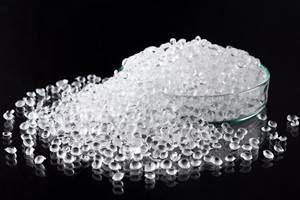Use MFR Cautiously with Filled Materials
Materials Know How
If melt flow rate tests are used to evaluate the effect of processing on the average molecular weight of the polymer, the applicable rules must consider the contribution of the filler to the test result.
Recently I received a request to perform MFR testing on a glass-fiber reinforced PBT polyester to determine whether the material had been degraded during molding. Some of the parts were exhibiting brittle behavior, and a reduction in molecular weight—often referred to as degradation—is always a possible cause for reduced ductility. In many polymers, a relatively straightforward relationship exists between average molecular weight and melt flow rate (MFR). Therefore, comparing the MFR of the raw material to related molded parts can provide some information on how well the polymer survived the molding process.
It is difficult to obtain unanimous agreement on the benchmark value that should signal the need for concern regarding the molecular weight of the polymer. When using MFR, some cite an allowable increase of 30%, others use 40%, and a few even opt for changes as small as 20-25%. However, the original work on this problem, performed largely on materials like polycarbonate and PBT, actually used a measurement stated in terms of melt viscosity.
Using a correlation between melt viscosity and impact performance, a guideline was established that limited the viscosity reduction to 30%. This has been interpreted by many as justification for employing a limit of 30% when measuring an increase in MFR. But the two statements are not equivalent. A 30% reduction in melt viscosity is actually equal to a 43% increase in MFR when the tests are performed at the same conditions. Therefore, there is some justification for using 40% as an upper allowable limit.
This guideline works for many polymers, provided that the compound is unfilled. Unfortunately, interpreting MFR results for filled materials is not as simple because during processing the fillers can also be affected in a manner that contributes to the increase in MFR of the compound. This is especially true of materials that contain a reinforcement such as glass fiber. First, consider that the addition of the glass increases the melt viscosity or decreases the MFR of the material even if the average molecular weight of the polymer is unchanged.
As an example, an unfilled polycarbonate with an MFR of 10 g/10 min, when filled with 10% glass fiber, will have an MFR of 7.5 g/10 min. At a 20% loading the MFR drops to about 4 g/10 min. The molecular weight of the polymer has not changed, but the addition of the fiber makes the compound more viscous and this is reflected in the MFR.
When an unfilled polymer is processed, the elevated temperatures and residence time associated with the process can break the polymer chains, reducing the average molecular weight and decreasing the melt viscosity. Short chains flow more easily than long ones, and the MFR will display a corresponding increase. Failure to remove enough moisture from the resin can aggravate this problem for some polymers such as polycarbonates and polyesters.
But many processes such as injection molding and extrusion also generate a substantial amount of mechanical work. This work has the effect of reducing the length of the glass fibers. And this reduction in fiber length will cause an increase in MFR that is independent of changes in the molecular weight of the polymer. So when MFR tests are performed on glass-filled materials, the change in MFR is a compound effect of a change in the average molecular weight of the polymer and the length of the fibers. Consequently, the allowable increase in MFR for filled materials is greater and the more filler there is in the compound the greater this change can be before we become concerned about the health of the product.
This has been verified by correlating MFR results with another test called intrinsic viscosity (IV). IV tests work by dissolving the compound in a solvent and measuring the viscosity of the solution relative to that of the pure solvent. The higher the molecular weight the more viscous the solution becomes for a given concentration. In these tests the fillers are removed because they do not dissolve and they precipitate out before the test is performed. Tests have shown that relatively large increases in MFR for filled compounds are actually associated with comparatively small changes in IV, confirming that much of the MFR increase has nothing to do with polymer degradation.
But judging which changes are allowable and which are excessive can be tricky. Tests must be performed in order to correlate MFR increases with performance. The accompanying table shows the results of some of these studies on a range of materials and illustrates the effect that increasing amounts of glass fiber have on the permissible increases in MFR.
As straightforward as this concept is, it is not something of which many analysts are aware. So when a lab tested some brittle parts and obtained an MFR value of nearly 40 g/10 min based on a specification that appeared to read 18 g/10 min, they did the math, obtained a value of 111% for the increase, and declared the polymer degraded. But the compound contained 20% glass fiber, so based on the accompanying table the change that had been measured should not be related to the observed brittleness.
There was a second complicating factor. The MFR specification was not given as a mass flow but as a volumetric flow. A close look at the data sheet revealed that the specification read 18 cm3/10 min but the lab reported its results in grams/10 min. The melt density of the material is 1.40 g/cm3, so the mass MFR specification is actually 25.2 g/10 min (18 x 1.40). When this new baseline is used, the parts look even better, exhibiting an increase of only 60%. This is still above the benchmark value of 40% for an unfilled product, and therefore could still be interpreted as signaling a processing issue; however IV tests confirm that the polymer is not degraded.
Judging the condition of filled materials becomes even more difficult when the type or amount of filler changes. Mineral fillers, for example, because of their lower aspect ratio, undergo smaller changes in geometry and therefore contribute less to any observed change in viscosity. Long glass fibers are extremely problematic because their average length is much greater than the size of the orifice in the MFR instrument. This can result in values that defy interpretation.
The solution is provided by the IV test, which eliminates the contribution of the filler. However, IV tests require an apparatus that is more expensive and more complicated than the MFR tester and involves working with some rough chemicals. And some polymers such as PPS and PEEK are extremely difficult to dissolve and can make this type of testing impractical. In addition, many suppliers of filled materials provide an MFR specification, which encourages the practice of performing this test on these compounds. But it is important to keep in mind that if MFR tests are used to evaluate the effect of processing on the average molecular weight of the polymer, the applicable rules must consider the contribution of the filler to the test result.
Related Content
Additives Boast Sustainability Without Sacrificing Performance
Sustainability continues to dominate new additives technology, but upping performance is also evident. Most of the new additives have been targeted to commodity resins and particularly polyolefins.
Read MoreAt NPE2024, Follow These Megatrends in Materials and Additives
Offerings range from recycled, biobased, biodegradable and monomaterial structures that enhance recyclability to additives that are more efficient, sustainable and safer to use.
Read MoreICIS Launches: Ask ICIS Generative AI Commodities Assistant
Said to be the first of its kind, this AI assistant will enhance access to ICIS’ intelligence and insights for the energy and chemical markets.
Read MoreK 2022 Additives & Materials: Sustainability in the Lead
Nearly all of the new additives highlighted at the big show are aimed at enhancing recyclability of commodity resins and some volume engineering resins such as nylon and PC. A few new materials, on which we had not previously reported, also surfaced at K 2022.
Read MoreRead Next
See Recyclers Close the Loop on Trade Show Production Scrap at NPE2024
A collaboration between show organizer PLASTICS, recycler CPR and size reduction experts WEIMA and Conair recovered and recycled all production scrap at NPE2024.
Read MorePeople 4.0 – How to Get Buy-In from Your Staff for Industry 4.0 Systems
Implementing a production monitoring system as the foundation of a ‘smart factory’ is about integrating people with new technology as much as it is about integrating machines and computers. Here are tips from a company that has gone through the process.
Read More
.jpg;width=70;height=70;mode=crop)



















